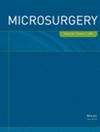Transverse division of the rectus abdominis muscle in deep inferior epigastric perforator flap elevation: A rescue technique to include more than one perforator
Abstract
Background
It is important to include as many perforators as possible in order to enhance the vascularity of a deep inferior epigastric perforator (DIEP) flap. However, the rectus muscle must be transected transversely, which prevents suturing and can cause a defect along the same line as the muscle-sparing procedure. When harvesting the DIEP flap, no specific method was suggested to solve these muscle defects. We found that by transecting the rectus muscle transversely, the muscle could be sutured in the tendinous area more easily while maintaining muscle function. The purpose of this study is to confirm the long-term recovery of the rectus abdominis muscle through the volume change after DIEP flap using this tendinous transection and suture method.
Patients and Methods
A retrospective review of 28 patients who underwent unilateral breast reconstruction using a DIEP flap and the tendinous transection method for multiple perforators between May 2018 and April 2020 was conducted. The preoperative and postoperative volumes of the rectus abdominis muscle were estimated both the harvest and opposite sides.
Results
The preoperative and postoperative muscle volumes from the harvest side were 50.08 ± 8.71 cm3 and 48.56 ± 8.61 cm3, respectively. The volume difference was 1.522 cm3 decrease, which was not statistically significant (p = .070). The preoperative and postoperative muscle volumes from the opposite side were 50.50 ± 8.15 cm3 and 50.08 ± 8.18 cm3, respectively. The volume difference was 0.434 cm3 increase and was not statistically significant (p = .064). Postoperative volume changes in the rectus muscle were not statistically significant on either side.
Conclusion
The tendinous transection method in the DIEP flap procedure did not significantly affect postoperative rectus muscle volume. Therefore, we expect this harvest method to allow DIEP flap reconstruction that includes multiple perforators and complete donor muscle recovery.

 求助内容:
求助内容: 应助结果提醒方式:
应助结果提醒方式:


